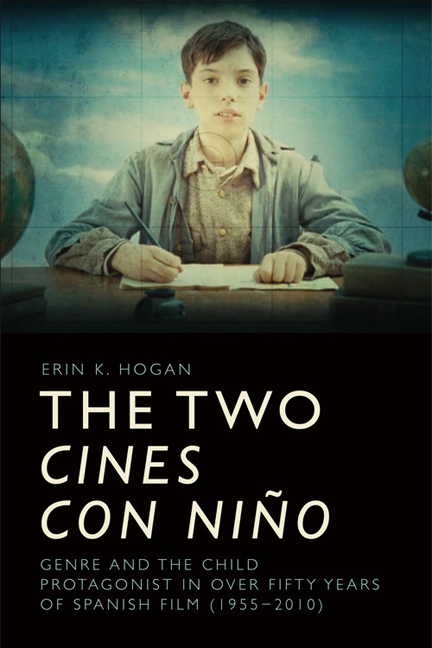Book contents
- Frontmatter
- Contents
- List of Figures
- Acknowledgements
- Figure Permissions
- Introduction The Two Cines Con Niño: The Ventriloquism, Dialogism and Biopolitics of the Children of Franco in Genre Film
- 1 The Black Market and the Stolen Children of Franco in Demonios En El Jardín
- 2 The Appropriative and Carnivalesque Ventriloquism of Altar Boys from Joselito in El pequeño ruiseñor to Ignacio in La mala Educación
- 3 Ventriloquism, Kidnapping and the Carnivalesque in Marisol’s Tómbola
- 4 Adopting, Adapting and Appropriating in the cines con niño: Un rayo de luz and El viaje de Carol
- 5 Prosopopeia and the Gothic Child from Marcelino pan y vino to El Orfanato
- 6 Dialogism and Ritual Function of the Nuevo Cine Con Niño: El Espíritu De La Colmena, Secretos Del Corazón And El Laberinto Del Fauno
- 7 Queering Post-war Childhood in Urte Ilunak and Pa Negre
- 8 The Transatlantic Dialogism in Narrative and Aesthetics of Bildungsfilms: La Lengua De Las Mariposas, Machuca, El Espíritu De La Colmena, El Premio, El Laberinto Del Fauno And Infancia Clandestina
- Conclusion Spanish Movies: Genre, Nation and Spanish Movie
- Select Filmography
- Select Bibliography
- Index
Conclusion Spanish Movies: Genre, Nation and Spanish Movie
Published online by Cambridge University Press: 01 May 2021
- Frontmatter
- Contents
- List of Figures
- Acknowledgements
- Figure Permissions
- Introduction The Two Cines Con Niño: The Ventriloquism, Dialogism and Biopolitics of the Children of Franco in Genre Film
- 1 The Black Market and the Stolen Children of Franco in Demonios En El Jardín
- 2 The Appropriative and Carnivalesque Ventriloquism of Altar Boys from Joselito in El pequeño ruiseñor to Ignacio in La mala Educación
- 3 Ventriloquism, Kidnapping and the Carnivalesque in Marisol’s Tómbola
- 4 Adopting, Adapting and Appropriating in the cines con niño: Un rayo de luz and El viaje de Carol
- 5 Prosopopeia and the Gothic Child from Marcelino pan y vino to El Orfanato
- 6 Dialogism and Ritual Function of the Nuevo Cine Con Niño: El Espíritu De La Colmena, Secretos Del Corazón And El Laberinto Del Fauno
- 7 Queering Post-war Childhood in Urte Ilunak and Pa Negre
- 8 The Transatlantic Dialogism in Narrative and Aesthetics of Bildungsfilms: La Lengua De Las Mariposas, Machuca, El Espíritu De La Colmena, El Premio, El Laberinto Del Fauno And Infancia Clandestina
- Conclusion Spanish Movies: Genre, Nation and Spanish Movie
- Select Filmography
- Select Bibliography
- Index
Summary
How Does the Panish Movie Become the Spanish Movie?
The Spanish Movie house indeed is haunted. Ramira, Roberta, Ramona, Raimunda, or Rigoberta (Alexandra Jiménez) – it is so hard even for co-stars to keep the recurring characters in Spanish cinema straight – arrives to a mansion to care for photo-sensitive Simeón (Óscar Lara), but sends him for fresh air outside where he is charred to death by the sun. The medium Gerarda (Juana Cordero), named and modelled after Geraldine Chaplin's actual Spanish nickname and heavy accent (French rather than English here) and fictional character in El orfanato (Bayona 2007), tries to locate the disappeared boy. She asks: ‘¿Qué es un fantasma, Carlos?’ (‘What is a ghost, Carlos?’), invoking the central question and main character of El espinazo del diablo (Del Toro 2001). Maligna (Teresa Lozano) may be responsible, like the suspect Benigna (Montserrat Carulla) from Bayona's film. Meanwhile, the pastime of Simeón's unconcerned sister Ofendia (Laia Alda) is to torture Faunofarfollas (Joaquín Reyes) and Hada (Michelle Jenner). Ramira, who incarnates many of Penélope Cruz's roles, falls in love with Pedro San Antón (Carlos Areces), who plays a number of Javier Bardem's award-winning parts. Perhaps this is why Pedro is bludgeoned with a Goya award statuette. Their Mar adentro (Sea Inside) (Amenábar 2004) – inspired love story culminates in a hybrid Abre los ojos (Open Your Eyes) (Amenábar 1997) – La comunidad (Common Wealth) (De la Iglesia 2000) sequence. Spanish Movie concludes with a deliberately unbelievable ‘Hollywood’ happy ending: Simeón is resurrected and the characters fly blissfully through the air together like superheroes.
Spanish Movie is, like the ‘Faunofarfollas’ named ‘Ambrosio’, an irreverent and entertaining salad of intertextual references and stock characters for Spanish cinema freaks. Ruiz Caldera's film illustrates many of the elements that form the nuevo cine con niño genre. Spanish Movie speaks to national cinema, the relationship between genre and nation, the inter textuality of genre cinema and its function. In Chapters Two, Four, and Five, I focus on continuities across the cines con niño, from the 1950s to the 2000s, arguing that similar narrative strategies serve the opposing political purposes and genre functions of the two Spains. I analysed the ideological function, Rick Altman's theorisation that follows Louis Althusser and reads genre as a vehicle for a regime's indoctrination (1999: 27), of the Francoist cine con niño in the most depth in Chapter Three.
- Type
- Chapter
- Information
- The Two cines con niñoGenre and the Child Protagonist in Fifty Years of Spanish Film (1955–2010), pp. 200 - 209Publisher: Edinburgh University PressPrint publication year: 2018



